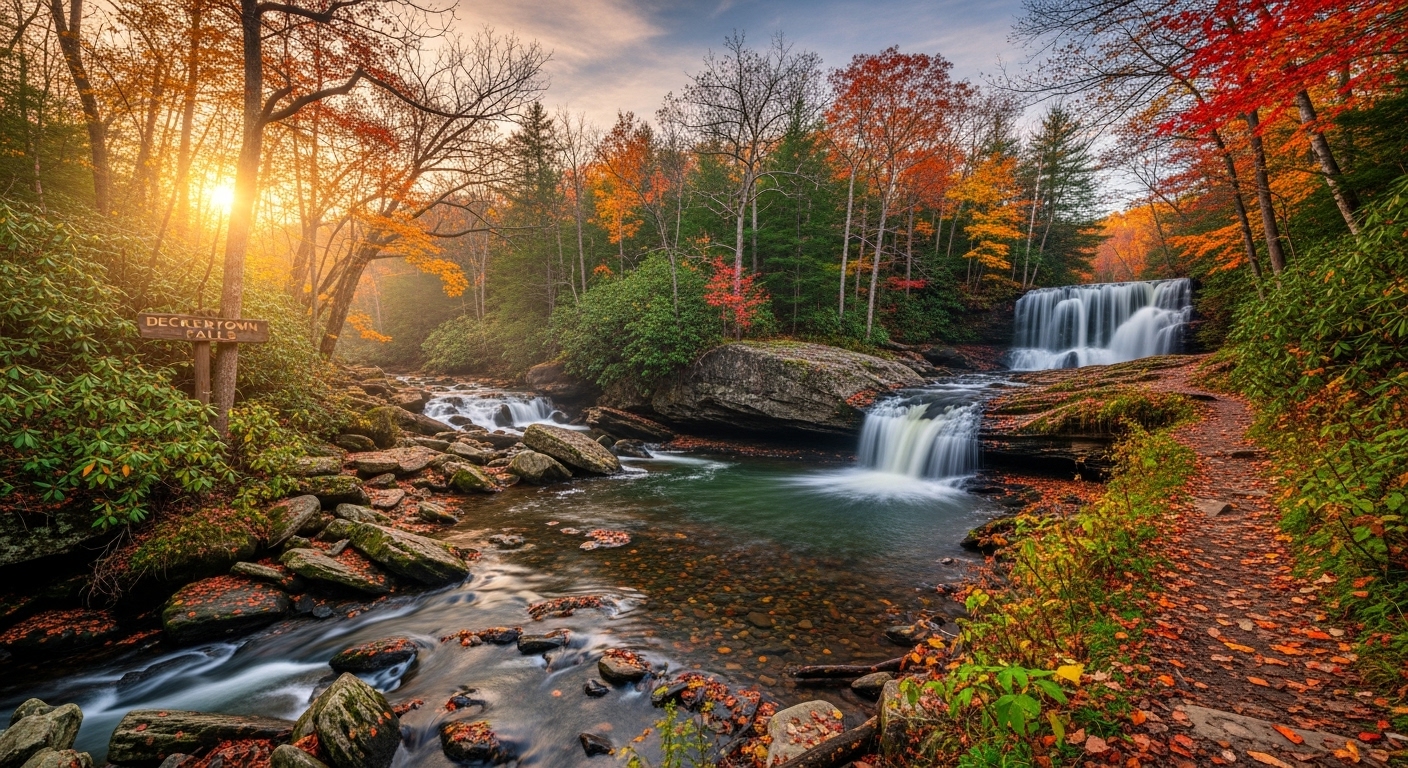While the names Watkins Glen and Taughannock often dominate conversations about the Finger Lakes’ dramatic gorges, a truly magnificent, yet often overlooked, natural wonder lies just outside the quaint village of Montour Falls: Deckertown Falls. This multi-tiered cascade carves a deep, lush ravine into the landscape, consequently offering adventurous hikers a more rugged, intimate, and profoundly rewarding experience away from the crowds. Ultimately, it stands as a spectacular testament to the powerful, shaping forces that defined this corner of New York State.
I. The Deep History and Geology of the Falls
To truly appreciate Deckertown Falls, you must look beneath the surface to its geological origins. The Finger Lakes region is a landscape sculpted by continental glaciers, and Deckertown Creek, the water source for the falls, is no exception.
Glacial Sculpting and Shale Strata
Deckertown Falls is a prime example of a hanging valley waterfall, a common feature in this area. Millions of years ago, the bedrock here consisted primarily of soft shale and harder sandstone, which were laid down in ancient seas. Later, when the massive glaciers retreated, they deepened the main valley (now Montour Falls), thereby leaving the side creeks (like Deckertown Creek) “hanging” high above the valley floor.
Consequently, the creek has rapidly cut down through the exposed rock layers over millennia, preferentially eroding the softer shale layers beneath the more resistant sandstone caprocks. This process results in the distinctive stepped, vertical drops that characterize the falls.
The Falls Structure
Furthermore, Deckertown is not a single waterfall but a complex, nearly mile-long series of cascades that drop over 100 feet in elevation.
-
The Lower Cascades: First, find these gentle riffles and small drops closest to the road; they serve as an easy entry point.
-
The Main Tier (The Plunge): Next, the most photogenic section features the highest single drop, plunging into a deep, cold basin surrounded by mossy, dark shale walls.
-
The Upper Gorge: Finally, this area requires the most effort to reach but rewards visitors with a deep, shaded chasm featuring several smaller, secluded slides and drops, giving a true sense of untouched wilderness.
II. 🥾 Navigating the Trail: A Hiker’s Guide
Deckertown Falls offers a moderate to challenging hike that therefore requires preparation and respect for the natural environment.
| Trail Aspect | Detail | Safety Note |
| Difficulty | Moderate to Difficult | Note that the trail is generally short but rugged and steep in sections. |
| Footwear | Absolutely require waterproof hiking boots. | Because the trail often follows the creek bed, it is perpetually wet and slippery. |
| Distance | Approximately 0.5 to 1 mile (one way) to the upper sections. | Distance is variable depending on how far you choose to explore. |
| Elevation Gain | Approximately 100 feet. | The gain is concentrated over short, steep distances. |
Trail Conditions and Essential Safety
Unlike the paved paths of state parks like Watkins Glen, the Deckertown trail is natural and unmarked. Although following the creek is the primary route, the terrain can be treacherous.
-
Slipperiness: Specifically, the presence of fine silt and moss on the wet shale makes many surfaces incredibly slick. Take deliberate, careful steps.
-
Flash Flood Risk: When heavy rain occurs, the creek can rise quickly and become dangerous. Therefore, never enter the gorge during or immediately after a severe storm.
-
Private Property: In addition, be aware that the land surrounding the gorge is a mix of public access and private property. Always respect posted signs and stay within the known creek bed corridor.
Local Tip: Plan your visit for the spring (April/May) since the snowmelt maximizes the flow, turning the cascades into thundering torrents. Also, the fall foliage surrounding the dark shale walls in October is breathtaking.
III. 📸 Capturing the Scene: Photography Notes
Deckertown Falls is a photographer’s dream, for it offers dynamic compositions of moving water and dramatic rock faces.
-
Use a Tripod: A tripod is essential for long exposure shots to capture the silky, misty effect of the water flow. Shutter speeds between $0.5$ and $2$ seconds usually work well.
-
Polarizing Filter (CPL): Moreover, a polarizer is crucial for reducing glare and reflections off the wet rocks and water surface, which intensifies the lush green and deep brown colors.
-
Time of Day: Visit on an overcast day or in the early morning/late afternoon. Otherwise, direct sunlight creates harsh contrasts and blown-out highlights that are difficult to manage in the deep gorge.
IV. Completing Your Montour Falls Adventure
Deckertown Falls is perfectly situated to be the adventurous counterpart to the more serene attractions nearby.
-
Shequaga Falls: Drive a few minutes into the Village of Montour Falls to see this magnificent cascade plummet over 150 feet right beside the main street—a truly unique urban waterfall.
-
Watkins Glen State Park: Located less than 10 minutes away, Watkins Glen offers its world-famous system of stone bridges and tunnels, thus providing a contrasting, highly developed hiking experience.
-
Seneca Lake Wine Trail: Finally, you are immediately adjacent to the eastern shore of Seneca Lake, making the falls a perfect prelude or conclusion to a day of visiting local wineries, breweries, and distilleries.
Deckertown Falls indeed remains one of the Finger Lakes’ best-kept secrets—a place where the commitment of a rugged hike is richly rewarded by the sight and sound of truly powerful, untamed nature. It’s an essential stop for anyone seeking the authentic, wild heart of New York’s gorge country.

